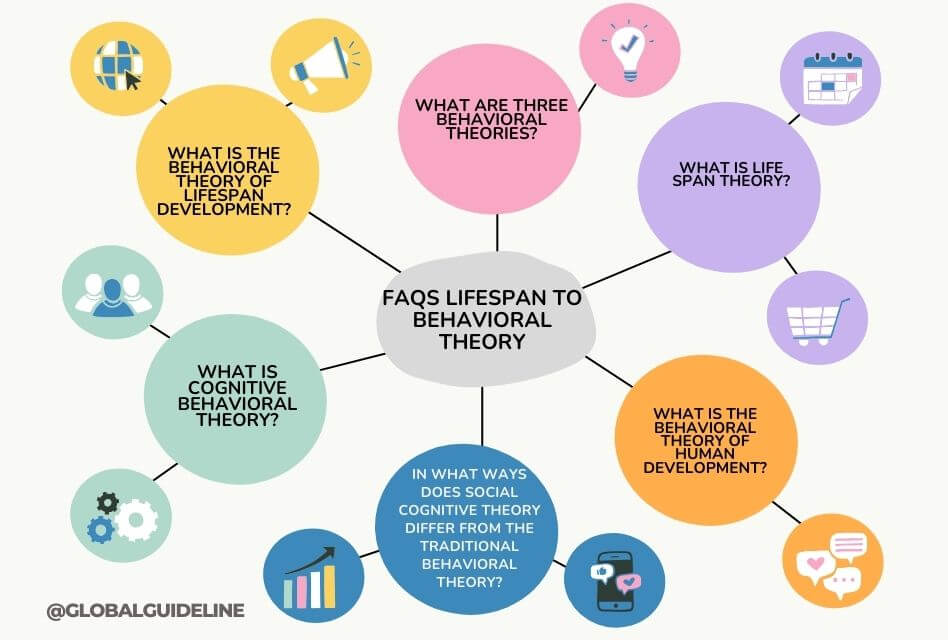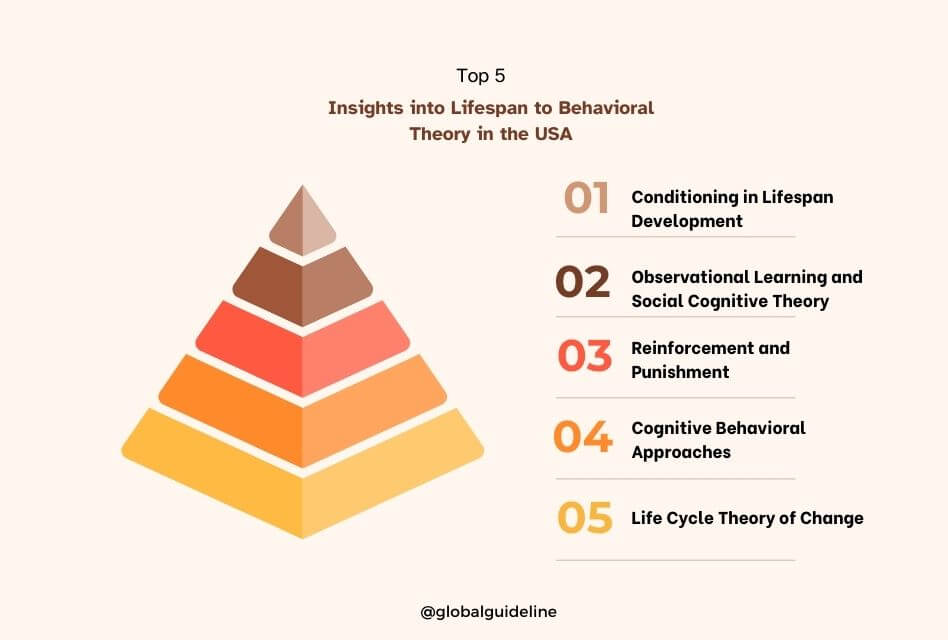This knowledge of human development is very important across various industries, such as psychology, education, and healthcare. The overlap of life span into behavior theory offers a broad and all-embracing basis to study how a behavior changes from infancy to old age. In this blog post, the top five insights into lifespan to behavioral theory will be explored concerning the relevance in the USA and contributes to our understanding of human development.
Table of Contents

What Is Behavioral Theory of Lifespan Development?
Let me give you a closer look at the main findings, first providing with an explanation of what the behavioral theory of lifespan development is. Behavioral theory, in the context of the study of lifespan development, takes into account the idea that behaviors are learned and come from interaction with the environment or living environment throughout the life course. Thus, according to the theory, behavior is a product of conditioning, reinforcement, as well as observational learning, which all occur through different times of life.
What is Behavioral Theory?
According to behavioral theory, all behaviors are learned through conditioning. From this root, it was developed from the works of early 20th-century psychologists such as John B. Watson and B.F. Skinner, who emphasized observable behavior instead of internal mental states. Over time, behavioral theory grew to encompass several types of behavioral learning: whereas classical conditioning, developed by Ivan Pavlov, explains how the behaviors are acquired and maintained over time, operant conditioning was championed by B.F. Skinner.
What Is the Lifespan Theory?
Lifespan theory emphasizes development from birth to death. This perspective considers the biological, psychological, and social changes that affect development. It is holistic because development is a life long process and not one that ends once childhood is reached. Put together with behavioral theory, lifespan theory offers a very strong background for understanding how behavior changes and evolves throughout one’s life.
1. Conditioning in Lifespan Development
Among the key insights to a behavioral theory of lifespan development is the role conditioning plays in life-long molding and shaping of behavior. It involves or rather, centers around classical or operant conditioning as the basis for how we learn and become accustom to behaviors as stages of life occur.
Classical vs. Operant Conditioning
The theory of classical conditioning explains how a neutral stimulus can be associated with an unconditioned stimulus so as to elicit a conditioned response. For example, in experiments that Ivan Pavlov conducted on dogs, he demonstrated that pairing a neutral stimulus, such as a bell, with an unconditioned stimulus, like food, caused the dogs to react gradually by salivating on their own in anticipation of ringing the bell.
Operant conditioning, however, is learning based on reinforcement and punishment. B.F. Skinner’s work showed how behaviors could be increased or decreased based on the consequences that follow them. The strengthening of a behaviour in positive reinforcement is due to the rewarding stimulus that follows after a behavior has been exhibited.
Applications Across the Life Cycle
Conditioning is a fundamental aspect of life cycle development. Beginning with infancy, children learn behaviors through their reward or punishment, and extending into adulthood, complex behaviors are formed from consequences of actions taken. In one case, the child learns not to touch a hot stove again because of a burn (operant conditioning), while in another, the adult develops a conditioned response to stress from repeated exposure to stressful situations.
2. Observational Learning and Social Cognitive Theory
Another key contribution throughout the lifespan to behavioral theory is the importance of observational learning, particularly as introduced through social cognitive theory. Albert Bandura’s social learning theory generalizes that a person learns new behaviors by observing others-a phenomenon known as vicarious learning.
Observational Learning and Vicarious Reinforcement
Observational learning takes place when the individual observes and imitates the actions of others. The most critical time for this to be effective is during childhood, but it affects people throughout their lives. Vicarious reinforcement occurs when people see others who receive reinforcement for what they do or don’t do and whether they will imitate the behavior.
Albert Bandura and Social Cognitive Theory
Social cognitive theory-the psychological model by Albert Bandura extended the understanding of behavioral theory. Bandura’s learning theory combined the aspects of cognitive elements into the learning process, which said that people are not blank slates responding passively to their environment but active processors of information, thinking about the consequences of their behavior after learning from others.
Lifespan Application
Learning and modeling behavior is an omnipresent process in a person’s lifetime-from a child learning about social norms through observing their parents to an adult adjusting to expectations in the workplace by paying attention to what colleagues do. Indirect learning through observation is the most important idea grasped to understand how people manage social milieus throughout their lives.
3. Reinforcement and Punishment
Reinforcement and punishment are two influential concepts under the behavioural theory. These have substantially influenced behavior patterns from childhood to adult life. There is therefore a very great need to explain how these two work in real life. This will go a long way in appreciating how this whole theory applies in different areas of life.
Types of Reinforcement and Punishment
Positive reinforcement : An indarpent reinforcing stimulus is added to increase the probability of behavior. Negative reinforcement : An aversive stimulus is removed to increase the chances of behavior. Punishment : A behavior is less likely by introducing an undesirable consequence or removing a positive stimulus.
Behavioral Theory in Human Development
Reinforcement and punishment have therefore remained as very important tools in shaping behavior at different life stages. For example, a parent will praise or reward good behavior in children. Similarly, schools can use negative reinforcement by awarding students not to do homework and attend classes if they are performing well in class.
Lifespan Implications
However, the nature and source of reinforcement and punishment change with age. At work, positive reinforcement may be promotion or pay; negative reinforcement may be the elimination of an undesirable task. It is through knowledge of these forces that one can apply behavioral theory from cradle to grave.
4. Cognitive Behavioral Approaches
This combines the cognitive theory with the traditional principles of behavior so as to provide a more complete view of human behaviors. Such an integration is required for the proper application of the lifespan theory towards behavioral theory.
What Is Cognitive Behavioral Theory?
This is a theory that combines the principles of behavioral and cognitive processes. Life-span perspective gives the suggestion that how people think about a situation is what affects their behavior. The approach is mostly applied in the therapeutic setting to handle a range of behavioral and emotional problems.
Life-Span Perspective
From the life course perspective, the cognitive behavioral approach would prove to be of much help in attaining the changing cognitive and behavioral needs of a person in their several life phases. For example, a young individual may be taught methods by cognitive-behavioral techniques for other means of coping with pressure, while an elderly individual may utilize such methods for anxiety or depression.
Practice Applications
Cognitive behavioral techniques are implemented within schools and workplaces and even through therapy programs for individuals in efforts to modify what are deemed maladaptive behaviours and thought forms. Combining cognitive and behavioral approaches allows practitioners to offer interventions that may be more tailored for different interventions across the life cycle.

5. Life Cycle Theory of Change
Another important insight into how behavioral theory applies throughout the lifespan is the life cycle theory of change. The argument of life cycle theory is that behavior change is a sequential process and requires different challenges and strategies at different stages.
Stages of Change
In the life cycle theory of change, there are stages that an individual goes through with regards to modification of behaviour. The stages include the following: pre-contemplation, contemplation, preparation, action, and maintenance. They describe the different levels of readiness for change that require different strategies and interventions.
Behavioral Theory and Change
Behavioral theory has the tools to help the individual progress through all stages of the change process. For instance, in the preparation stage, incentives help encourage an individual to continue on a course of action, while in the maintenance stage, continued incentives allow new behaviors to be maintained.
Lifespan Application
Changes in behavior may be initiated at any time throughout life-stopping a bad habit, making an adjustment towards better health, or improving work performance. Understanding the stages of change and using the appropriate behavioral techniques would allow for successful modification at any age.
FAQ Section
Q: What is the behavioral theory of lifespan development?
A: Behavioural theory of lifespan development discusses learning and maintaining behaviors throughout life using conditioning, reinforcement, and observational learning. This theory situates the principles of behavioral theory in the context of human development and behavior over the life course.
Q: What are three behavioral theories?
A: The three major behavioral theories are classical conditioning, operant conditioning, and social learning theory. These theories describe how behavior is learned and modified through a variety of learning and reinforcement mechanisms.
Q: What is life span theory?
A: Life span theory is a framework that studies the processes of development from birth to death, accounting for biological, psychological, and social changes that influence development across the life cycle.
Q: What is the behavioral theory of human development?
A: The behavioural theory of human development focuses on how people learn behaviors through interactions with the environment with a focus on conditioning and reinforcement in behavior acquisition throughout the life course.
Q: In what ways does social cognitive theory differ from the traditional behavioral theory?
A: Albert Bandura developed social cognitive theory by assimilating cognitive processes into the typical behavioural theory. The theory indicates that individuals learn and actively process information and behaviors by seeing other individuals and not just on direct reinforcement.

Conclusion
The intersection of lifespan with behavioral theory necessarily provides an interactive understanding of how behaviors are learned, maintained, and changed over the lifecycle. Exploring the roles of conditioning, observational learning, reinforcement, cognitive behavior approaches, and the life cycle theory of change can unveil deeper insights into human development and behavior.
These insights are valuable not only to psychologists and educators but to anyone interested in understanding the dynamics of behavior that cut across stages of life. The applications of these theories in practical settings then help us to augment learning, improve behavioral outcomes, and support positive change across the lifespan.
Related Posts:
7 Ways Performing Manufacturing Operations Boosts Supply Chain Success










